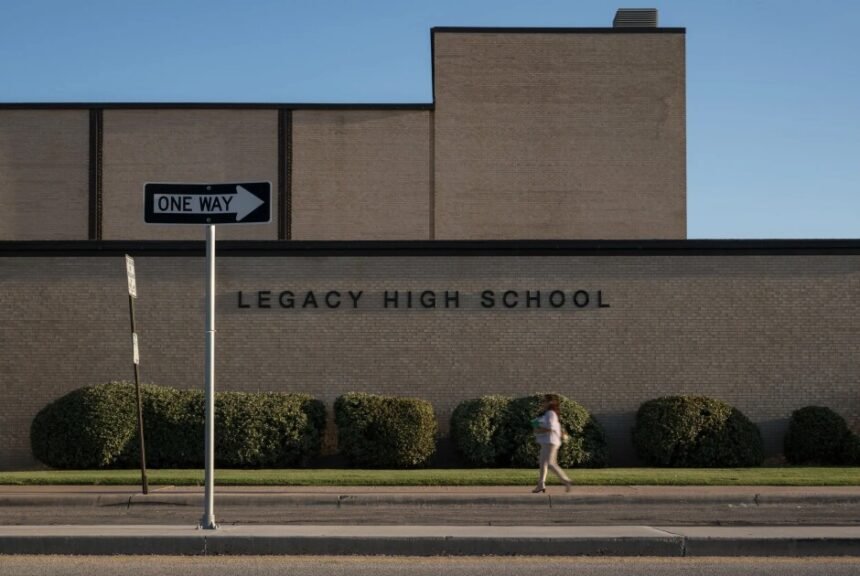A Texas school district will rename two schools to reference the Confederate army commander, making it the second district in recent years to resurrect Confederate names that were previously retired in the past half-decade due to their racist connotations.
Midland Independent school district—located in western Texas, roughly 320 miles west of Austin—will change its current high school and 9th grade campus to Midland Lee High School and Midland Lee Freshman High School, respectively, roughly five years after the school board voted to drop the schools’ connection to Confederate Gen. Robert E. Lee. The schools were renamed to Legacy High School and Legacy Freshman High School in 2020, from Robert E. Lee High School and Robert E. Lee Freshman High School.
It’s the second school district to reverse course and resurrect Confederate names, according to an EdWeek analysis of schools that bear the names of Confederate figures. One district in Virginia reverted two school names in May 2024.
The restoration of the Confederate names is happening during a radically different political moment from when districts changed dozens of school names after the 2020 police murder of George Floyd in Minneapolis prompted a sharper nationwide focus on systemic racism. Now, President Donald Trump’s administration is attempting to root out diversity, equity, and inclusion efforts from schools and other parts of government. The president himself has also waded into a battle over a New York district’s refusal to drop a Native American mascot prohibited by a state policy.
At Midland’s school board meeting Tuesday, where the school board ultimately approved the new names in a 4-3 vote, tensions ran high. Early in the meeting, amid speaker after speaker denouncing the name reversal, Board President Brandon Hodges called on the crowd to settle down.
“This is a public meeting. This is an emotional topic,” he told the auditorium. “Everybody is going to be polite to each other and has the right to come up here and speak.”
During hours of public comment leading up to the vote, a majority of speakers decried the prospect of the board changing the schools’ names, arguing such a decision would be racist and harmful to students of color. A much smaller contingent urged the board—which oversees a district of 40 schools and almost 29,000 students, two-thirds of whom are Hispanic and 7 percent of whom are Black, and 40 schools—to change the names back to Lee.
The board members in favor of the change said they were not honoring Lee, but rather the school’s history.
“It does not reference any one specific individual but explicitly references the school’s 60 years of family, hard work, and accomplishments in sports and academics,” Hodges said.
Hodges did not respond to a request for comment.
Board member Matt Friez, who also supported the name change, said he was moved by the speakers’ testimony, but asserted that a history of racism and prejudice in schools, churches, and government buildings “many decades ago … is not a legitimate reason to tear down, bulldoze, rename, or repaint much of America’s infrastructure.”
He added, “We live in a time where being offended has almost become a way of life or an addiction for some.”
Board member Sara Burleson said she received eight emails supporting the renaming of Legacy to Lee, but 70 in favor of keeping Legacy. That, coupled with the ratio of speakers on Tuesday, showed where the sentiment was in the community, she argued.
“This is a name on a building that students walk through every day, and I’m committed, as a trustee, to make sure every student is safe, secure, and enters a building that is inclusive of all students,” she said. “The word ‘legacy’ doesn’t exclude anyone or make them feel uncomfortable. But the name Lee does.”
The district’s superintendent said at Tuesday’s meeting it could cost up to $62,000 to rebrand the schools. The change will take effect in the 2026-27 school year, and will also affect the name of a future high school currently under construction.
Schools were phasing out Confederate names, but the tide has started to change
In October 2020, the Midland district had voted to change the schools’ names, and convened a committee to review potential new names.
At the time, some favored retaining “Lee” in its schools’ identities in place of the full Robert E. Lee name as a way to both distance the district from the Confederate leader’s history but appease alumni and retain some of the school’s historical identity. One of the renaming committee’s suggestions, which garnered the most votes, was to use “LEE” as an acronym for “Legacy of Excellence and Equality,” according to the Texas Tribune.
Ultimately, however, the school board struck Lee altogether and approved the name “Legacy” instead.
The move followed a trend seen across the country in that period, when schools retired Confederate school names and Native American mascots and logos. It was part of a larger wave that spread nationally following Floyd’s killing.
Advocates of such changes have long argued that the use of Confederate and Native American names is harmful to students of color.
There were two main periods during the 20th century that saw a surge in Confederate namings and monument placements—around World War I and following World War II—often as a backlash to the advancement of civil rights. After World War II, as the Civil Rights Movement gained traction, schools were named after Confederate leaders, statues were placed in their honor, and state flags were redesigned to incorporate the Confederate flag, experts say.
Approximately 340 schools in 21 states—largely concentrated in the Southeast—currently bear the names of Confederate figures, according to Education Week’s research. Since June 29, 2020, at least 59 Confederate-named schools have been changed to non-Confederate names, and have not been changed back.
In May 2024, after voting to change names in 2020, the Shenandoah County, Va., school district reversed course and reinstated the Confederate names of two schools, honoring Stonewall Jackson and Ashby Lee. Several school districts have similarly reinstated Native American mascots, despite public outcry.







